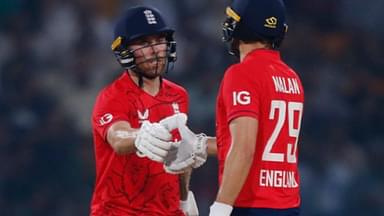What is powerplay in cricket: The Powerplay rules are different for a T20 international and an One-day international match in Cricket.
Advertisement
In a game which is already tilted in favour of the batters, Powerplay is the leader of the reasons why the same is believed so. The rule, which is applicable only in the limited-Overs format, refers to a set to fielding restrictions which dictates the position of fielders whether inside the 30-yard circle or outside of it.
Teams posting and chasing targets in excess of 300 has a lot to to with the Powerplay Overs as well, which restricts the placement of fielders to be stationed at any part of the ground at will.
In the ODIs these Overs are divided into three phases, and in two phases during the T2oIs.
What is powerplay in cricket
As per the ICC, the rules of Powerplay in ODIs at present, which has been in place since 2015 are as follows:
Mandatory Powerplay (Overs 1-10) – During an ODI match comprising 50 Overs, only a maximum of two fielders are allowed to stand outside the 30-yard circle during this phase.
Overs 11 to 40 – During this phase, not more than four fielders are allowed to stand outside the 30-yard circle.
Overs 41 to 50 – This phase provides a bit of a relief to the bowlers, as they can now place a maximum of five fielders outside the 30-yard circle.
As per the ICC, the rules of Powerplay in T20Is at present are as follows:
-Overs 1 to 6 – Only a maximum of two fielders are allowed to stand outside the 30-yard circle during this phase.
6th Over onwards – A maximum of five fielders are allowed outside the 30-yard circle.
A change of strategy by India post T20 WC 2021. Emphasis more on strike rate than saving wickets. India Powerplay run-rate 8.82 (highest in the world). Rohit Sharma’s SR in PP 160 (highest for any batter). Message is clear: 15-ball 30s are better than 40-ball 50s. #EngvInd
— Mazher Arshad (@MazherArshad) July 9, 2022
Powerplay history in ODIs over the years
The ODI match has witnessed a host of amendments to the initial Powerplay Overs, which was introduced by the ICC in the year 2005. Here too, the phase was split into three divisions with the first ten Overs being mandatory Powerplay with only two fielders permitted outside the 30-yard circle and two fielders at catching positions within the circle.
The next two phases comprised five-Overs each, with the fielding team to decide when to take them during the innings. Two close catchers were not mandatory in this case.
In the year 2008, the ICC decided to allow the batting side to take one of the aforementioned two Powerplays.
Then from October 1, 2011, the ICC decided that the batting and the bowling Powerplay cannot be taken before the 16th Over and must be completed by the 40th Over. This means that Overs 11-15 and 41-50 cannot be used as Powerplay Overs by either of the teams.
Just a year later, the ICC decided to do away with the bowling Powerplay, with now only the batting side to take the five-Over powerplay by the 40th Over of the ODI. Also, while three fielders were now allowed to be stationed outside the circle, the number reduced to four from five fielders during the non-powerplay Overs.
From 2015 onwards, the batting and bowling powerplays were entirely done away with, with the entire innings now divided into three phases, as mentioned above.
BBL Bash Boost
Australia’s premier T20 tournament Big Bash League (BBL) also follow what is known as the ‘Bash Boost’. Here the chasing team gets rewarded with a bonus point for scoring more than their opposition at the 10-Over mark. In case the team batting second could not surpass the opposition score after 10 Overs, the fielding side gets the bonus point.

